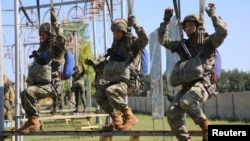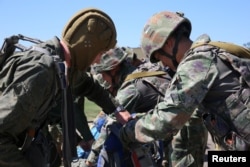Military exercises under way this week between China and Belarus are seen by experts as a response to NATO's growing interest in the Asia-Pacific region and a signal that China's involvement in Europe will continue to grow.
Just one day before the start of this week's NATO summit where Japan and South Korea were major participants, China began 11 days of anti-terrorism exercises with Belarus in Brest, a city on the border with NATO member Poland.
Belarus has been a crucial supporter of Russian President Vladimir Putin's invasion of Ukraine, which borders both Belarus and Poland.
The drills, collectively titled "Eagle Assault 2024," were designed to increase military interoperability and allow the two states "to work out the issues of night landing, overcoming water obstacles, and conducting operations in a populated area," according to a statement from the Belarusian Ministry of Defense.
As the exercises continued, military representatives from China and Belarus met over the course of two days to discuss joint logistics, further entrenching the two sides' ability to collaborate in military affairs.
During a regular news conference on Thursday, Chinese Foreign Ministry spokesperson Lin Jian said questions about the implications of the drills on NATO and Polish security should be referred to "competent authorities." Chinese military collaboration with Belarus "does not target any particular country," he said.
The exercises reflect deepening ties between China and Belarus, the newest country to join the Chinese- and Russian-led Shanghai Cooperation Organization. Its president, Alexander Lukashenko, recently participated in high-level meetings with Chinese President Xi Jinping and Foreign Minister Wang Yi.
Following talks in Beijing on Monday between Wang and his Belarusian counterpart, the Chinese foreign minister "expressed China's willingness to deepen high-level exchanges, strengthen strategic synergy and deepen all-round cooperation with Belarus to advance their all-weather, comprehensive strategic partnership," Chinese state media reported.
The countries also agreed to "oppose external interference and resist unilateral bullying," Chinese state news channel CGTN said.
'Tremendous progress' in ties
In a comment to VOA, Yun Sun, director of the China program at the Stimson Center, wrote that since the expansion of China's Belt and Road Initiative to Belarus, political solidarity and trade between the two countries has seen "tremendous progress."
Reflecting on the significance of Belarus to China, she added, "Belarus [offers] China strong support in Eastern Europe and the Global South."
The two countries are united by their support for Russia's war on Ukraine, authoritarian political systems and general discontent with the Western-led international order. China often directs its diplomatic efforts to similar states, notably maintaining an alliance with North Korea and a "no limits" strategic partnership with Russia.
Exercises with Belarus point to a larger shift in Chinese foreign policy, with China's focus on Eastern Europe as a frontier for engagement developing in recent months.
During his landmark European tour in May, Xi made stops in Serbia and Hungary. He has committed to building a "Chinese-Serbian community with a shared future in the new era" and has elevated relations with Hungary to an "all-weather comprehensive strategic partnership."
As China has developed ties with Eastern Europe, it has continued to support Russia's invasion of Ukraine, offering Russia an economic buffer against Western sanctions and providing Russia with dual-use technology that may be used in weapons aimed at Ukraine.
"China has supported Russia for its war in Ukraine in many clandestine ways, but Beijing remains fearful that it will be punished with Western sanctions if it starts giving overt military support to Russia," Eoin Micheál McNamara, a researcher at the Finnish Institute of International Affairs, wrote in a comment to VOA's Mandarin Service.
"Supporting Belarus, a close ally of Moscow, is signaling to the West that China is prepared to get involved with military cooperation close to EU and NATO borders," he added.
NATO 'acting like a bully'
China's objection to NATO's involvement with South Korea and Japan is clear. Lin, in a Tuesday news conference, said that the alliance "keeps reaching beyond its boundary, expanding its mandate, stoking confrontation and acting like a bully on the world stage. … NATO should not use China to justify its insertion into the Asia-Pacific and attempt to disrupt regional dynamics."
Analysts say the military collaboration with Belarus in particular marks a new chapter in China's European foreign policy objectives.
"China has been very cautious and careful about extending military presence to Europe, or areas traditionally seen as close to NATO's core area," Sun wrote. "This joint exercise changes that. Given the timing, the exercise is evidently linked to the NATO summit in Washington that has Japanese and Korean participation. It is tit-for-tat."
Ali Wyne, senior research and advocacy adviser for U.S.-China at the International Crisis Group, wrote to VOA: "With the United States reinvigorating its core alliances and partnerships in Europe and Asia — and increasingly working to integrate those relationships — China seeks to demonstrate that it can assemble coalitions of its own, including by deepening its ties with U.S. competitors and adversaries, promulgating its Global Security Initiative, and expanding groupings such as the Shanghai Cooperation Organization."
Michal Bogusz, an analyst at the Polish Center of Eastern Studies, views the Eagle Assault exercise and increasing collaboration between Beijing and Belarus as a part of a global expansion of informal relationships among authoritarian regimes.
"After Putin's visit to [North Korea] and the support he gave to this Chinese ally, now Beijing is supporting Belarus, a Russian ally. This also should make [it clear] that Putin's visit in Pyongyang was from the beginning coordinated with Xi Jinping, and the China-Russia de facto alliance is not only getting stronger but also more aggressive," Bogusz wrote to VOA's Mandarin Service.
Beijing, Moscow and Minsk will meet at the Shanghai Cooperation Organization summit in 2025, with China assuming the organization's rotating presidency for the coming year.









